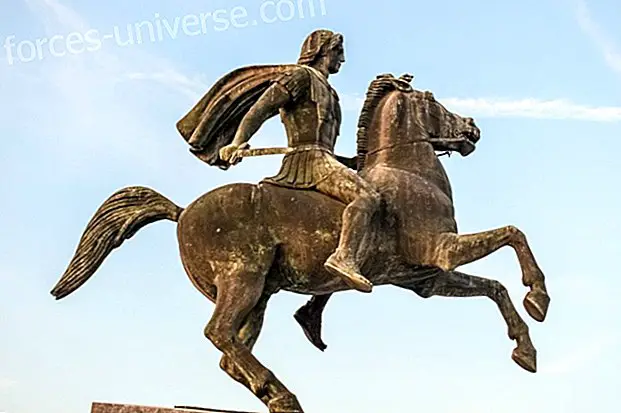This article is aimed at all women who want to know each other more deeply and, for all those men who would like to understand a little more women who are part of their life.
All women at some time in life have personified different roles or social roles, either because we had to do it or because we felt that way. These patterns of behavior or desire that arise from the depths of our being are called by Jungian psychiatrist Jean Shinoda Bolen as archetypes . These archetypes are like behavioral patterns that determine our reactions, decisions and feelings . This expert psychiatrist made a classification of these behavior patterns, archetypes, into three groups of seven types of goddesses living in us or rather prototypes that we personify throughout our lives. And thanks to which you can achieve a more accurate understanding of our attitudes or desires.

This archetype is like a kind of "internal strength" that affects both what we do and what we feel . This is why a deeper knowledge of the subject can help us and help men to understand a little more our way of thinking and feeling in certain situations.
The expert psychiatrist takes, in order to explain these internal forces of women, to the Greek Goddesses as the personification or symbolic representation of these forces . In this way, Jean Shinoda affirms that the internal forces would be the archetypes, a term incorporated by Jung, or patterns that differentiate one woman from another .
Returning to the words of Jean Shinoda Bolen “The Jungian perspective has made me aware that women are influenced by powerful internal forces, or archetypes, that can be personified by the Greek goddesses . And the feminist perspective has provided me with an understanding of how external forces, or stereotypes - the roles that society expects women to adapt to - reinforce some goddess patterns and repress others . As a consequence, I see each woman as an "intermediate woman" : driven from within by archetypes of goddesses and from outside by cultural stereotypes . "

What do the Goddesses symbolize?
Goddesses are internal images . They are archetypes, internally predetermined roles, which can be activated, more than one, in a woman. Greek goddesses are images of women who have lived in the imagination of humanity for thousands of years. These goddesses personify patterns of how women are, historically challenging traditional society who always determined a brief repertoire of behaviors which they can take / perform and not others. These goddesses are beautiful, strong, brave, warriors, powerful, lovers. They are motivated by what really matters to them. They represent intrinsic patterns or archetypes that can shape the course of a woman's life. These goddesses differ from each other . Each has its positive and potentially negative traits . Their myths show, just what is important to them and express with metaphors what a woman who looks like them can do . Each Greek goddess of Mount Olympus was unique, and some of them antagonistic to each other, which expresses Jean Shinoda Bolen is like a "metaphor for the diversity and inner conflict of women, we are complex and multifaceted."
The goddesses, all of them, are dormant, in the psyche of a woman . Usually one of them has dominion, but it can happen that several goddesses compete for control of the woman's mind . If this happens, it is time for her to make a decision about what aspect of herself she wants to express and at what time. If you do not make this decision, you will be tamed first by one aspect and then by another, so it will be totally contradictory in your behavior . The Greek goddesses, Shinoda recalls, also lived, like us, in a patriarchal society . “Male gods ruled the earth, the heavens, the ocean and the underground world. Each independent goddess adapted to this reality in her own way, separating herself from men, joining men as one of them or retreating into her own interior. Each goddess valued a concrete relationship was vulnerable and relatively weak compared to the male gods, who could deny her what she wanted and dominate her. Thus, the goddesses represent patterns that reflect the life of a patriarchal culture. ”

Classification of the Goddesses
Jean Shinoda Bolen took seven goddesses from Greek culture and classified them into three groups:
- Virgin Goddesses
- Vulnerable Goddesses
- Alchemist or transforming goddesses
What distinguishes each group are the motivations themselves, the forms of consciousness, the attitude towards life and others, the need for affection and of course, the importance that each one gives to relationships . We must bear in mind that in our psyche, several goddesses can be activated at the same time.
The goddesses of each woman as a tool of internal understanding
1) THE GODDESS VENDAS: ARTEMISA, ATHENS AND HESTIA
This group of virgin goddesses is constituted by Artemis, goddess of the hunt and the moon; Athena, goddess of wisdom and crafts; and Hestia, goddess of home and temples.
These women, each in their own way, represent active, independent and non-related aspects for female psychology .
In this way the archetypes that tend outwards and therefore towards the achievement of concrete objectives, are in charge of Athena and Artemis . Therefore, the tendency to go in is in the hands of Hestia .
All three represent internal impulses in women that have to do with competition, with the pursuit of their own interests, with the resolution of problems, with the expression both in the language and the language artistic, impart order and be contemplative .
Paraphrasing Jean Shinoda Bolen any woman who feels or has felt that she needed a place for herself, that has felt nature as her own home, that appreciates loneliness or enjoys investigating or finding out how something works, then this woman possesses some n kind of kinship or similarity with these virgin goddesses .
Virgin refers to the lack of colonization, possession, for example when a town was never colonized or an island was never penetrated, named. In the case of women, it refers to a woman who was not colonized, taken by a man . It is necessary to clarify that this term refers not only to the physical but also to the psychological aspect .

2) THE VULNERABLE GODDENS: HERA, DEMÉTER AND PERSÉFONE
This set consists of the following three goddesses: Hera, goddess of marriage, Demeter, goddess of crops, and Persephone also known as maiden, goddess and queen of the underground world.
These goddesses represent the traditional roles of a woman in any kind of society, saving those cultures in which these roles do not exist.
These functions are: mother, wife and daughter.
These goddesses care a lot about relationships, so their self-esteem and emotional state will depend a lot on the quality of their bonding relationships. As you will realize, these women need to satisfy their desire for relationship. Your primary need is affiliation.
REDACTORA: Gisela S., editor of the great family of the White Brotherhood.
CONTINUE: What Goddess or Goddesses are you? by Gisela S.
PART 2:
SOURCE: Bolen, JS (2012). The goddesses of each woman: a new feminine psychology. Kairos editorial.






